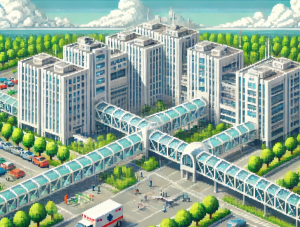
What Happens When You Rethink Health Care as a Network?
A woman in her 70s, living with diabetes, needs more than a doctor’s visit. She needs transportation to appointments, affordable healthy food nearby, someone to explain her medications, and a neighbor who checks in on her. She needs care that understands her whole life, not just her blood sugar levels.
This is where integrated care comes in—and why it must evolve.
A groundbreaking study just updated the Development Model for Integrated Care (DMIC), one of the most widely used frameworks for designing health systems that actually work for people. After combing through 179 studies, researchers added 20 new elements to better reflect the world we live in now—a world shaped by digital innovation, social connection, and a deeper understanding of what it means to be healthy.
So, what did they find? And how could this change how we care for people?
A Model Born from Complexity—and Ready for Change
The DMIC is a conceptual model that helps public health leaders, health care professionals, and community organizations design integrated health services—systems that coordinate care across sectors like housing, education, and mental health.
First created over a decade ago, the DMIC captured 89 essential “elements” of integrated care grouped into nine clusters like teamwork, client-centeredness, and transparent leadership.
But the world has changed. New technology, shifting demographics, and increasing social needs demanded a closer look. So the research team launched a massive review, asking: Which pieces of the puzzle are missing?
The answer: twenty new elements, and five major “accents” that reflect how care is changing—and must continue to evolve.
Five Key Shifts That Could Reshape Public Health
1. Clients Aren’t Just Patients—They’re Partners
Gone are the days of top-down care. The new model emphasizes that clients—also called service users—and their families, friends, and communities must be seen as equal partners in health.
That means more shared decision-making, deeper inclusion of people’s social environments, and listening to the lived experiences of families and caregivers.
What this means for you: If you work in care delivery or system design, it’s not enough to “do to”—you need to “do with.” Invite, involve, and honor the expertise of people living the realities of care.
2. Proactive, Preventive, and Holistic
The updated model recognizes a truth we’ve all known: waiting until someone is sick is too late. Integrated care must look upstream.
New elements focus on proactive health promotion, early intervention, and life-course approaches—addressing the factors that shape health before someone ever walks into a clinic.
Think: healthy food access, safe environments for activity, and culturally relevant education on prevention.
3. Digital Care Isn’t a Bonus—It’s a Backbone
From telehealth visits to online care portals, digital tools have become central to modern care. But many models still treat them as add-ons.
Not anymore.
The DMIC now includes digital information sharing, virtual services, and hybrid care systems as core parts of integrated care—acknowledging how technology connects clients, professionals, and data like never before.
As health systems move toward interoperability and AI, digital integration will only grow in importance.
4. Ethics, Identity, and Values Matter
Effective collaboration isn’t just about logistics—it’s about trust, respect, and shared purpose.
The updated DMIC reflects the rising importance of values-based partnerships, especially across organizations with different cultures or missions. It emphasizes the role of ethics, psychosocial support, and inclusive practices in building strong care networks.
This matters especially when working in diverse communities or across sectors like justice, education, or housing.
5. Zoom Out: The Ecosystem Approach
Perhaps the biggest shift? A move from viewing care as organizational coordination to seeing it as a community ecosystem.
Care doesn’t stop at hospital walls. The DMIC now incorporates broader systems thinking—how policy, geography, local partnerships, and even other networks shape what’s possible.
It’s a call to think big and work wide.
Why This Matters Now
The COVID-19 pandemic exposed just how fragile, fragmented, and unprepared many health systems were. But it also showed what’s possible when care is coordinated, community-based, and flexible.
As we navigate ongoing workforce shortages, rising chronic conditions, and growing social inequities, integrated care isn’t a “nice to have”—it’s a survival strategy.
Updating models like the DMIC helps us learn from the past, respond to the present, and design better systems for the future.
What’s Next for Integrated Care?
This new version of the DMIC is already being used in places like the Netherlands, Germany, Canada, and Norway. But its real power lies in its flexibility—it’s meant to be adapted, customized, and built upon.
Still, questions remain:
- How do we measure whether integration actually improves lives?
- How can we scale local, context-specific innovations without losing what makes them work?
- And how do we keep models like the DMIC updated in a world that changes fast?
Researchers recommend updating the DMIC every five years—and possibly developing a shorter, validated version for easier use in real-world settings.
Join the Conversation
How would you apply these new elements in your work or community?
Do these updates reflect what you’re seeing on the ground?
What’s your vision for truly integrated, community-centered care?
We want to hear from you. Share your thoughts in the comments or tag us on social media.



